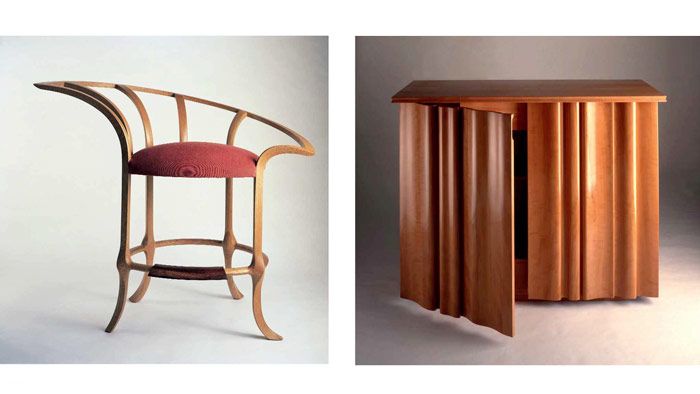My fascination with the ‘weird’
Megan Fitzpatrick is in awe of truly creative designers like David Savage, who can think “chair” but design and build something that not only functions well for its intended purpose, but also looks wildly different.

Earlier this month, I was working on a project for Lost Art Press that had me looking at every book the company offers. It was a semi-mindless task, so my mind was semi-free to wander. When I got to David Savage’s The Intelligent Hand, I reminisced about his 2016 visit to Kentucky and how much I enjoyed the few days I spent with him – and how I regret that time and circumstance didn’t afford me a chance to get to know him better, or to learn more directly from him (He died in early 2019). His work – as always – got me thinking about creativity, and how mine is comparatively limited.
While much of David’s incredible – almost anthropomorphic – furniture is in a style I’m never likely to want to design or build, I defy anyone to say it isn’t arresting, important, and incredibly interesting work. (If you don’t know it, I urge you to Google.) Yet, as he wrote in The Intelligent Hand, some of his chair design was based (in part) on a prosaic and beat-up Windsor chair he kept in his office: “I have an old American-made Windsor chair in the studio that I keep as a chair totem. I look at it and take measurements from it when questions come up such as: How wide should a chair be? How high should a seat be? This old chair is strong, light, comfy, and good-looking all around. All I have to do is that – but totally differently.”
It’s that “totally differently” that eludes me. I can look at a Shaker worktable, make a few design tweaks, and turn it into a bathroom vanity. I can look at the 1980s kitchen in my 1905 house and envision a new (OK, old) design that better fits it. But while I can look at the first chair in the image above and see what might be Windsor DNA, it’s only because David’s words had me searching for it. I would never have seen that chair and thought, “Ah – clearly it’s inspired by a traditional Windsor.” I am in awe of truly creative designers, those who can think “chair” but design and build something that not only functions well for its intended purpose, but also looks wildly different.

(At the risk of offending…I’ve seen a lot of “chairs” that are unique and do crazy creative things with wood…but that are better called “sculpture”; you wouldn’t want to sit in them for a long duration.)
I’m well aware that nothing I’ve designed (I use that term loosely) and made is new; it’s all derivative of every teacher I’ve had, every book and article I’ve read, every piece of furniture I’ve seen. But 20 years ago, I couldn’t (and wouldn’t) have looked at a Shaker worktable and considered design tweaks to make it into something else. That comes with experience – the knowing what’s possible after learning the how.
As David makes clear in The Intelligent Hand, students at the school he founded, Rowden Workshops, in Devon, England, get a firm grounding in all fundamentals of modern woodworking, from hand tools to power tools to computer-aided design, as well as drawing and business skills. Like all of us who build stuff, they first have to learn how.
Twenty years from now, though, when I’ve practiced and learned 40 years’ worth of how, I doubt I’ll be able to think beyond a known form to dream up something wholly new. “Non-traditional,” “new,” and “studio” simply aren’t in my aesthetic DNA – and that’s OK. I’m happy to practice and get better at building in styles that already exist. But though I don’t strive to design the ineffable, I’m glad there are extraordinarily creative people who do. They expand the understanding of what’s possible.
My point is this – Learn the foundations, then look at everything: the old, the new, things you love, things you hate, and always the altogether weird, then build what you love. Your weird could become the new prosaic. Or, as David writes, “Do what you believe to be excellent, and give not a stuff. History, not fashion, will determine whether your efforts are just OK or really great.” I’ll be over here, building in a style history has already approved – but I can’t wait to see what you do!

 |
Frame-and-Panel Carcasesby David Savage |
 |
|
 |
Fine Woodworking Recommended Products


Sketchup Class

Circle Guide























Comments
I concur - I have skill, but lack creativity (and probably skill too come to think of it). Always been the bane of my existence when I try my hand at something out of the ordinary. It comes out looking weird, not in a good way!
Log in or create an account to post a comment.
Sign up Log in